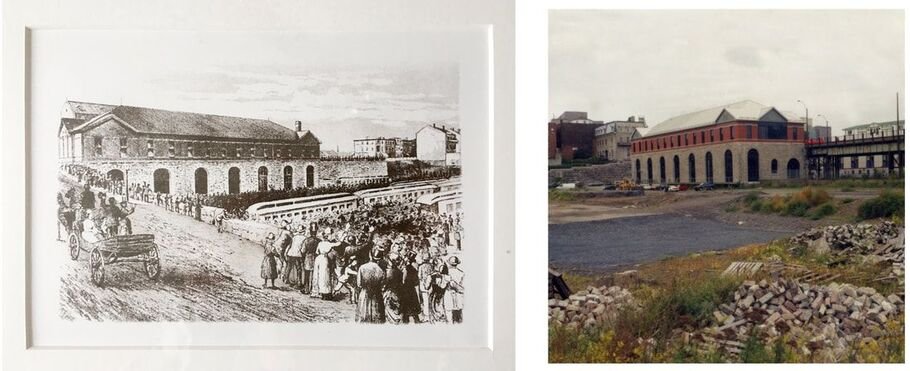Un Centre des Histoires
Site-specific project at 401, boulevard St Laurent, Old Montreal, 1993
Walter completed an MFA from Concordia University in Montreal in 1993. Her graduating thesis looked at the idea of the museum and the impossibility of representing a singular history of the city. She used ruins as points of departure to critique urban development, and explore loss in the pursuit of Western ideals of progress. Walter's "museum" occupied a vacant building at the foot of boulevard St Laurent in Old Montreal, around the corner from the city’s official Centre d’Histoire.
The main floor lobby space displayed layers of material remains from surrounding developments—tree roots, concrete, and railway spikes. Her research in the form of photographs and documents made up an archives on the second floor where images of ruins from the surrounding landscape were positioned as counterpoints to images of development sites in the area. In an anti-room, a 16mm film loop projected an image of the Lachine Rapids, the landmark that halted further exploration up the St Laurence River in the 1500s and led to the so-called "founding" of Montreal. Upon leaving, visitors were given a “souvenir” tape of the sound of water flowing through the Lachine Rapids.
The project ran for three weeks in May 1993. Through the opening week, a slide projector positioned in the second floor window projected the image of a bulldozer on the concrete wall across the street, boulevard St Laurent.
His eyes are staring, his mouth is open, his wings are spread. This is how one pictures the angel of history. His face is turned toward the past. Where we perceive a chain of events, he sees one single catastrophe which keeps piling wreckage upon wreckage and hurls it in front of his feet. The angel would like to stay, awaken the dead, and make whole what has been smashed. But a storm is blowing from Paradise; it has got caught in his wings with such violence that the angel can no longer close them. The storm irresistibly propels him into the future to which his back is turned, while the pile of debris before him grows skyward. This storm is what we call progress.
Walter's research included this excerpt from Walter Benjamin's Angel of History published in "Illuminations," translation. Harry Zohn, New York: Schocken Books, 1969.
The following photograph was first featured as part Un Centre des Histories
CPR Lands: Dalhousie Station/Faubourg Quebec, 1993
Exhibited with the touring group exhibition Track Records: Trains and Contemporary Photography curated by Marnie Fleming, 1997-99
Oakville Galleries; Museum of Contemporary Photography, Ottawa; Presentation House, Vancouver; The Illingworth Kerr Gallery, Calgary; Centre Culturel University of Sherbrooke, Quebec; Mackenzie Art Gallery, Regina; Winnipeg Art Gallery
Kathryn Walter’s work focuses on contemporary social landscapes… Her photographic series CPR Lands: Dalhousie Station/Faubourg Quebec, depicts the redevelopment of a nineteenth century railway site in Montreal… it combines a panorama of colour photographs with an archival image of the departure of the first transcontinental train from the same site in 1885…In contrast to the wide-angle sweep of a panoramic view, the image is fragmented into six separate views. This deliberate separation slows down the viewer’s experience of looking at the image, thereby heightening an awareness of a landscape in ruins.
(excerpt from catalogue text by Karen White)
The above panorama was shown next to the print below (left), a CPR publicity image used to celebrate the train's departure from the station. Below (right) shows the train station in the second panel of the panorama.
Track Records: Trains and Contemporary Photography included artists Roy Arden, Ron Benner, Vera Frenkl, Angela Grauerholz, O. Winston Link, Louise Noguchi, Glenn Rudolph, David Thomas, Douglas Walker, Kathryn Walter, James Welling





